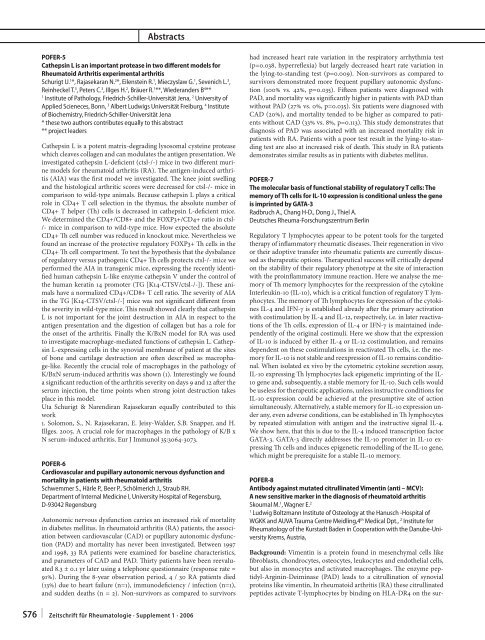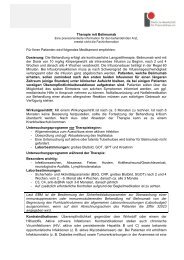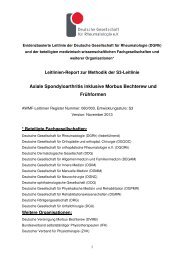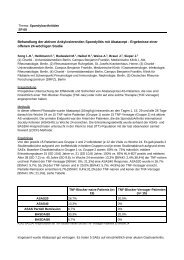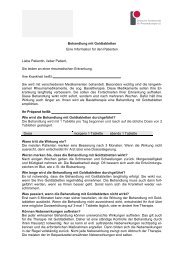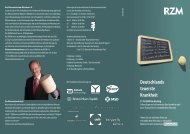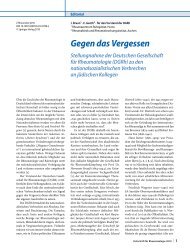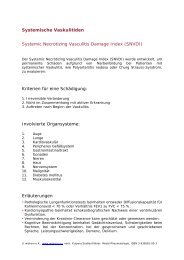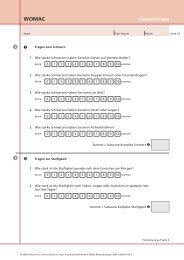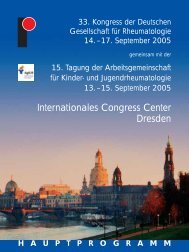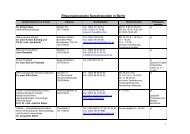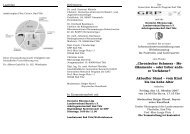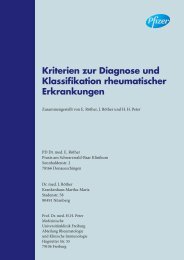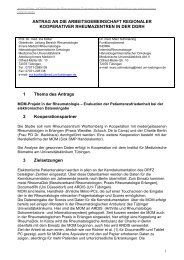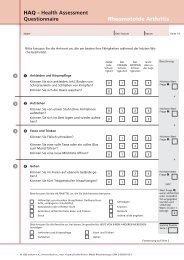Zeitschrift für Rheumatologie – Supplement 1 - Deutsche ...
Zeitschrift für Rheumatologie – Supplement 1 - Deutsche ...
Zeitschrift für Rheumatologie – Supplement 1 - Deutsche ...
Erfolgreiche ePaper selbst erstellen
Machen Sie aus Ihren PDF Publikationen ein blätterbares Flipbook mit unserer einzigartigen Google optimierten e-Paper Software.
S76<br />
Abstracts<br />
POFER-5<br />
Cathepsin L is an important protease in two diff erent models for<br />
Rheumatoid Arthritis experimental arthritis<br />
Schurigt U. 1 *, Rajasekaran N. 2 *, Eilenstein R. 1 , Mieczyslaw G. 1 , Sevenich L. 3 ,<br />
Reinheckel T. 3 , Peters C. 3 , Illges H. 2 , Bräuer R. 1 **, Wiederanders B 4 **<br />
1 Institute of Pathology, Friedrich-Schiller-Universität Jena, 2 University of<br />
Applied Scieneces, Bonn, 3 Albert Ludwigs Universität Freiburg, 4 Institute<br />
of Biochemistry, Friedrich-Schiller-Universität Jena<br />
* these two authors contributes equally to this abstract<br />
** project leaders<br />
Cathepsin L is a potent matrix-degrading lysosomal cysteine protease<br />
which cleaves collagen and can modulates the antigen presentation. We<br />
investigated cathepsin L-defi cient (ctsl-/-) mice in two diff erent murine<br />
models for rheumatoid arthritis (RA). Th e antigen-induced arthritis<br />
(AIA) was the fi rst model we investigated. Th e knee joint swelling<br />
and the histological arthritic scores were decreased for ctsl-/- mice in<br />
comparison to wild-type animals. Because cathepsin L plays a critical<br />
role in CD4+ T cell selection in the thymus, the absolute number of<br />
CD4+ T helper (Th ) cells is decreased in cathepsin L-defi cient mice.<br />
We determined the CD4+/CD8+ and the FOXP3+/CD4+ ratio in ctsl-<br />
/- mice in comparison to wild-type mice. How expected the absolute<br />
CD4+ Th cell number was reduced in knockout mice. Nevertheless we<br />
found an increase of the protective regulatory FOXP3+ Th cells in the<br />
CD4+ Th cell compartment. To test the hypothesis that the dysbalance<br />
of regulatory versus pathogenic CD4+ Th cells protects ctsl-/- mice we<br />
performed the AIA in transgenic mice, expressing the recently identifi<br />
ed human cathepsin L-like enzyme cathepsin V under the control of<br />
the human keratin 14 promoter (TG [K14-CTSV/ctsl-/-]). Th ese animals<br />
have a normalized CD4+/CD8+ T cell ratio. Th e severity of AIA<br />
in the TG [K14-CTSV/ctsl-/-] mice was not signifi cant diff erent from<br />
the severity in wild-type mice. Th is result showed clearly that cathepsin<br />
L is not important for the joint destruction in AIA in respect to the<br />
antigen presentation and the digestion of collagen but has a role for<br />
the onset of the arthritis. Finally the K/BxN model for RA was used<br />
to investigate macrophage-mediated functions of cathepsin L. Cathepsin<br />
L-expressing cells in the synovial membrane of patient at the sites<br />
of bone and cartilage destruction are oft en described as macrophage-like.<br />
Recently the crucial role of macrophages in the pathology of<br />
K/BxN serum-induced arthritis was shown (1). Interestingly we found<br />
a signifi cant reduction of the arthritis severity on days 9 and 12 aft er the<br />
serum injection, the time points when strong joint destruction takes<br />
place in this model.<br />
Uta Schurigt & Narendiran Rajasekaran equally contributed to this<br />
work<br />
1. Solomon, S., N. Rajasekaran, E. Jeisy-Walder, S.B. Snapper, and H.<br />
Illges. 2005. A crucial role for macrophages in the pathology of K/B x<br />
N serum-induced arthritis. Eur J Immunol 35:3064-3073.<br />
POFER-6<br />
Cardiovascular and pupillary autonomic nervous dysfunction and<br />
mortality in patients with rheumatoid arthritis<br />
Schwemmer S., Härle P., Beer P., Schölmerich J., Straub RH.<br />
Department of Internal Medicine I, University Hospital of Regensburg,<br />
D-93042 Regensburg<br />
Autonomic nervous dysfunction carries an increased risk of mortality<br />
in diabetes mellitus. In rheumatoid arthritis (RA) patients, the association<br />
between cardiovascular (CAD) or pupillary autonomic dysfunction<br />
(PAD) and mortality has never been investigated. Between 1997<br />
and 1998, 33 RA patients were examined for baseline characteristics,<br />
and parameters of CAD and PAD. Th irty patients have been reevaluated<br />
8.3 ± 0.1 yr later using a telephone questionnaire (response rate =<br />
91%). During the 8-year observation period, 4 / 30 RA patients died<br />
(13%) due to heart failure (n=1), immunodefi ciency / infection (n=1),<br />
and sudden deaths (n = 2). Non-survivors as compared to survivors<br />
| <strong>Zeitschrift</strong> <strong>für</strong> <strong>Rheumatologie</strong> · <strong>Supplement</strong> 1 · 2006<br />
had increased heart rate variation in the respiratory arrhythmia test<br />
(p=0.038, hyperrefl exia) but largely decreased heart rate variation in<br />
the lying-to-standing test (p=0.009). Non-survivors as compared to<br />
survivors demonstrated more frequent pupillary autonomic dysfunction<br />
(100% vs. 42%, p=0.035). Fift een patients were diagnosed with<br />
PAD, and mortality was signifi cantly higher in patients with PAD than<br />
without PAD (27% vs. 0%, p=0.035). Six patients were diagnosed with<br />
CAD (20%), and mortality tended to be higher as compared to patients<br />
without CAD (33% vs. 8%, p=0.113). Th is study demonstrates that<br />
diagnosis of PAD was associated with an increased mortality risk in<br />
patients with RA. Patients with a poor test result in the lying-to-standing<br />
test are also at increased risk of death. Th is study in RA patients<br />
demonstrates similar results as in patients with diabetes mellitus.<br />
POFER-7<br />
The molecular basis of functional stability of regulatory T cells: The<br />
memory of Th cells for IL-10 expression is conditional unless the gene<br />
is imprinted by GATA-3<br />
Radbruch A., Chang H-D., Dong J., Thiel A.<br />
<strong>Deutsche</strong>s Rheuma-Forschungszentrum Berlin<br />
Regulatory T lymphocytes appear to be potent tools for the targeted<br />
therapy of infl ammatory rheumatic diseases. Th eir regeneration in vivo<br />
or their adoptive transfer into rheumatic patients are currently discussed<br />
as therapeutic options. Th erapeutical success will critically depend<br />
on the stability of their regulatory phenotype at the site of interaction<br />
with the proinfl ammatory immune reaction. Here we analyse the memory<br />
of Th memory lymphocytes for the reexpression of the cytokine<br />
Interleukin-10 (IL-10), which is a critical function of regulatory T lymphocytes.<br />
Th e memory of Th lymphocytes for expression of the cytokines<br />
IL-4 and IFN-γ is established already aft er the primary activation<br />
with costimulation by IL-4 and IL-12, respectively, i.e. in later reactivations<br />
of the Th cells, expression of IL-4 or IFN-γ is maintained independently<br />
of the original costimuli. Here we show that the expression<br />
of IL-10 is induced by either IL-4 or IL-12 costimulation, and remains<br />
dependent on these costimulations in reactivated Th cells, i.e. the memory<br />
for IL-10 is not stable and reexpression of IL-10 remains conditional.<br />
When isolated ex vivo by the cytometric cytokine secretion assay,<br />
IL-10 expressing Th lymphocytes lack epigenetic imprinting of the IL-<br />
10 gene and, subsequently, a stable memory for IL-10. Such cells would<br />
be useless for therapeutic applications, unless instructive conditions for<br />
IL-10 expression could be achieved at the presumptive site of action<br />
simultaneously. Alternatively, a stable memory for IL-10 expression under<br />
any, even adverse conditions, can be established in Th lymphocytes<br />
by repeated stimulation with antigen and the instructive signal IL-4.<br />
We show here, that this is due to the IL-4 induced transcription factor<br />
GATA-3. GATA-3 directly addresses the IL-10 promoter in IL-10 expressing<br />
Th cells and induces epigenetic remodelling of the IL-10 gene,<br />
which might be prerequisite for a stable IL-10 memory.<br />
POFER-8<br />
Antibody against mutated citrullinated Vimentin (anti <strong>–</strong> MCV):<br />
A new sensitive marker in the diagnosis of rheumatoid arthritis<br />
Skoumal M. 1 , Wagner E. 2<br />
1 Ludwig Boltzmann Institute of Osteology at the Hanusch -Hospital of<br />
WGKK and AUVA Trauma Centre Meidling,4 th Medical Dpt., 2 Institute for<br />
Rheumatology of the Kurstadt Baden in Cooperation with the Danube-University<br />
Krems, Austria,<br />
Background: Vimentin is a protein found in mesenchymal cells like<br />
fi broblasts, chondrocytes, osteocytes, leukocytes and endothelial cells,<br />
but also in monocytes and activated macrophages. Th e enzyme peptidyl-Arginin-Deiminase<br />
(PAD) leads to a citrullination of synovial<br />
proteins like vimentin, In rheumatoid arthritis (RA) these citrullinated<br />
peptides activate T-lymphocytes by binding on HLA-DR4 on the sur-


